ESP MITSUBISHI OUTLANDER SPORT 2016 3.G Owners Manual
[x] Cancel search | Manufacturer: MITSUBISHI, Model Year: 2016, Model line: OUTLANDER SPORT, Model: MITSUBISHI OUTLANDER SPORT 2016 3.GPages: 398, PDF Size: 14.63 MB
Page 16 of 398
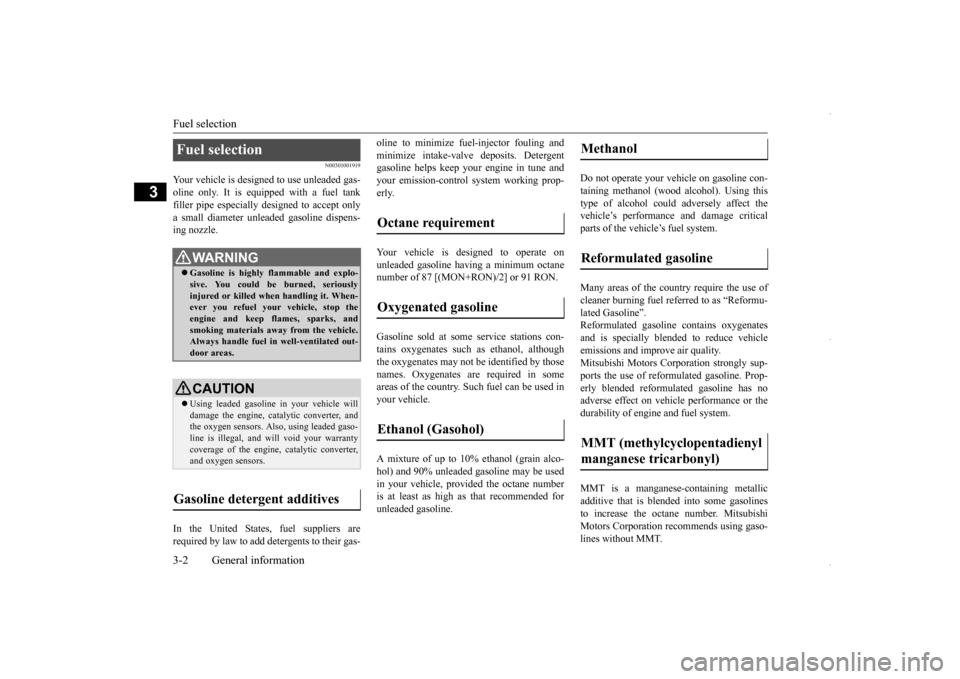
Fuel selection 3-2 General information
3
N00301001919
Your vehicle is designed to use unleaded gas- oline only. It is equipped with a fuel tankfiller pipe especially designed to accept only a small diameter unleaded gasoline dispens- ing nozzle. In the United States, fuel suppliers are required by law to add detergents to their gas-
oline to minimize fuel-injector fouling and minimize intake-valve deposits. Detergent gasoline helps keep your engine in tune and your emission-control system working prop-erly. Your vehicle is designed to operate on unleaded gasoline having a minimum octanenumber of 87 [(MON+RON)/2] or 91 RON. Gasoline sold at some service stations con- tains oxygenates such as ethanol, although the oxygenates may not be identified by those names. Oxygenates are required in someareas of the country. Such fuel can be used in your vehicle. A mixture of up to 10% ethanol (grain alco- hol) and 90% unleaded gasoline may be used in your vehicle, provided the octane numberis at least as high as that recommended for unleaded gasoline.
Do not operate your vehicle on gasoline con- taining methanol (wood alcohol). Using thistype of alcohol could adversely affect the vehicle’s performance and damage critical parts of the vehicle’s fuel system. Many areas of the country require the use of cleaner burning fuel referred to as “Reformu- lated Gasoline”.Reformulated gasoline contains oxygenates and is specially blended to reduce vehicle emissions and improve air quality.Mitsubishi Motors Cor
poration strongly sup-
ports the use of reformulated gasoline. Prop- erly blended reformulated gasoline has noadverse effect on vehicle performance or the durability of engine and fuel system. MMT is a manganese-containing metallic additive that is blended into some gasolinesto increase the octane number. Mitsubishi Motors Corporation recommends using gaso- lines without MMT.
Fuel selection
WA R N I N G Gasoline is highly flammable and explo- sive. You could be burned, seriouslyinjured or killed when handling it. When- ever you refuel your vehicle, stop the engine and keep flames, sparks, andsmoking materials away from the vehicle. Always handle fuel in well-ventilated out- door areas.CAUTION Using leaded gasoline in your vehicle will damage the engine, catalytic converter, and the oxygen sensors. Also, using leaded gaso-line is illegal, and will void your warranty coverage of the engine, catalytic converter, and oxygen sensors.
Gasoline detergent additives
Octane requirement Oxygenated gasoline Ethanol (Gasohol)
Methanol Reformulated gasoline MMT (methylcyclopentadienyl manganese tricarbonyl)
BK0229600US.bo
ok 2 ページ 2015年10月1日 木曜日 午後2時29分
Page 32 of 398
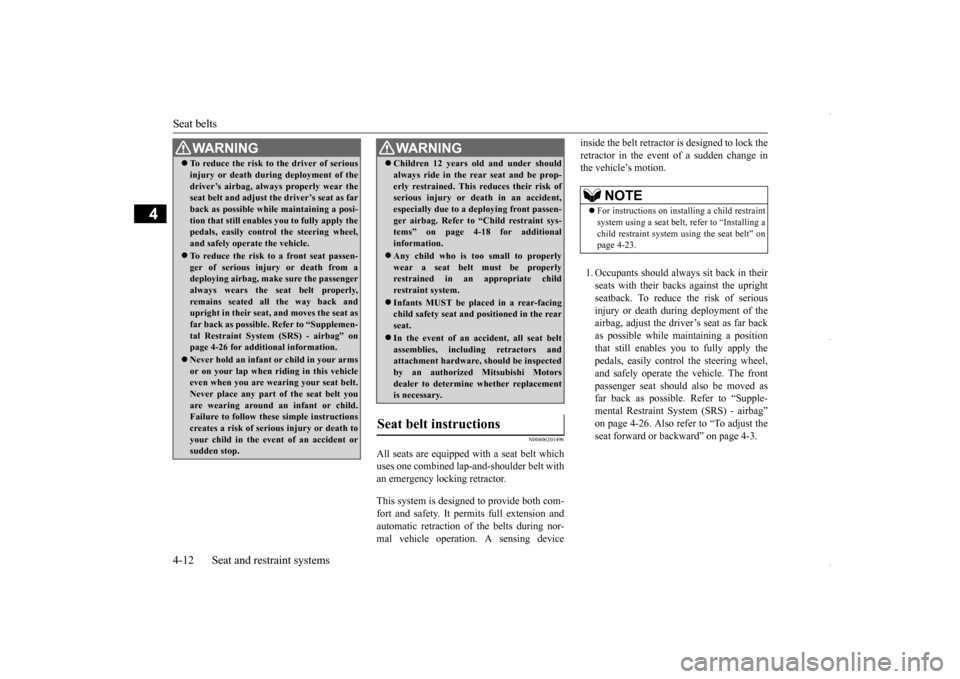
Seat belts 4-12 Seat and restraint systems
4
N00406201496
All seats are equipped with a seat belt which uses one combined lap-and-shoulder belt with an emergency locking retractor. This system is designed to provide both com- fort and safety. It permits full extension and automatic retraction of the belts during nor- mal vehicle operation. A sensing device
inside the belt retractor is designed to lock the retractor in the event of a sudden change in the vehicle’s motion. 1. Occupants should always sit back in their seats with their backs against the uprightseatback. To reduce the risk of serious injury or death during deployment of the airbag, adjust the driver’s seat as far backas possible while maintaining a position that still enables you to fully apply the pedals, easily control the steering wheel,and safely operate the vehicle. The front passenger seat should also be moved as far back as possible. Refer to “Supple-mental Restraint System (SRS) - airbag” on page 4-26. Also refer to “To adjust the seat forward or backward” on page 4-3.
To reduce the risk to the driver of serious injury or death during deployment of the driver’s airbag, always properly wear the seat belt and adjust the driver’s seat as far back as possible while maintaining a posi-tion that still enables you to fully apply the pedals, easily control the steering wheel, and safely operate the vehicle. To reduce the risk to a front seat passen- ger of serious injury or death from adeploying airbag, make sure the passenger always wears the seat belt properly, remains seated all the way back andupright in their seat, and moves the seat as far back as possible. Refer to “Supplemen- tal Restraint System (SRS) - airbag” onpage 4-26 for additional information. Never hold an infant or child in your arms or on your lap when riding in this vehicle even when you are wearing your seat belt. Never place any part of the seat belt youare wearing around an infant or child. Failure to follow these simple instructions creates a risk of serious injury or death toyour child in the event of an accident or sudden stop.WA R N I N G
Children 12 years old and under should always ride in the rear seat and be prop- erly restrained. This reduces their risk of serious injury or death in an accident, especially due to a deploying front passen-ger airbag. Refer to “Child restraint sys- tems” on page 4-18 for additional information. Any child who is too small to properly wear a seat belt must be properlyrestrained in an appropriate child restraint system. Infants MUST be placed in a rear-facing child safety seat and positioned in the rear seat. In the event of an accident, all seat belt assemblies, including retractors andattachment hardware, should be inspected by an authorized Mitsubishi Motors dealer to determine whether replacementis necessary.
Seat belt instructions
WA R N I N G
NOTE
For instructions on installing a child restraint system using a seat belt, refer to “Installing a child restraint system using the seat belt” on page 4-23.
BK0229600US.bo
ok 12 ページ 2015年10月1日 木曜日 午後2時29分
Page 38 of 398
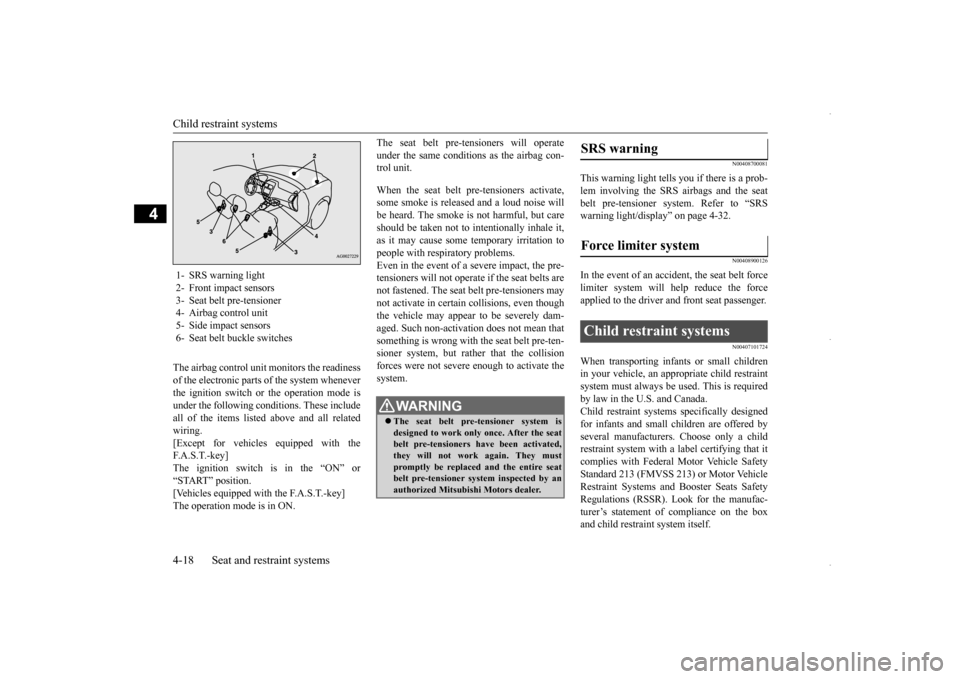
Child restraint systems 4-18 Seat and restraint systems
4
The airbag control unit monitors the readiness of the electronic parts of the system wheneverthe ignition switch or the operation mode isunder the following conditions. These include all of the items listed above and all related wiring.[Except for vehicles equipped with the F. A . S . T. - k e y ] The ignition switch is in the “ON” or“START” position. [Vehicles equipped with the F.A.S.T.-key] The operation mode is in ON.
The seat belt pre-tensioners will operate under the same conditions as the airbag con- trol unit. When the seat belt pre-tensioners activate, some smoke is released and a loud noise willbe heard. The smoke is not harmful, but care should be taken not to intentionally inhale it, as it may cause some temporary irritation topeople with respiratory problems. Even in the event of a severe impact, the pre- tensioners will not operate if the seat belts arenot fastened. The seat belt pre-tensioners maynot activate in certain collisions, even though the vehicle may appear to be severely dam- aged. Such non-activation does not mean thatsomething is wrong with the seat belt pre-ten- sioner system, but rather that the collision forces were not severe enough to activate thesystem.
N00408700081
This warning light tells you if there is a prob-lem involving the SRS airbags and the seatbelt pre-tensioner system. Refer to “SRS warning light/display” on page 4-32.
N00408900126
In the event of an accident, the seat belt force limiter system will help reduce the force applied to the driver and front seat passenger.
N00407101724
When transporting infants or small childrenin your vehicle, an appropriate child restraint system must always be used. This is requiredby law in the U.S. and Canada. Child restraint systems specifically designed for infants and small children are offered byseveral manufacturers. Choose only a child restraint system with a label certifying that it complies with Federal Motor Vehicle SafetyStandard 213 (FMVSS 213) or Motor Vehicle Restraint Systems and Booster Seats Safety Regulations (RSSR). Look for the manufac-turer’s statement of compliance on the box and child restraint system itself.
1- SRS warning light 2- Front impact sensors3- Seat belt pre-tensioner 4- Airbag control unit 5- Side impact sensors6- Seat belt buckle switches
WA R N I N G The seat belt pre-tensioner system is designed to work only once. After the seat belt pre-tensioners have been activated, they will not work again. They must promptly be replaced and the entire seat belt pre-tensioner system inspected by anauthorized Mitsubishi Motors dealer.
SRS warning Force limiter system Child restraint systems
BK0229600US.bo
ok 18 ページ 2015年10月1日 木曜日 午後2時29分
Page 45 of 398

Maintenance and inspection of seat belts
Seat and restraint systems 4-25
4
8. Before putting your child in the restraint, push and pull the restraint in all directions to be sure it is firmly secure. Do this before each use. If the child restraint sys-tem is not firmly secure, repeat steps 1 through 7. 9. To remove a child restraint system fromthe vehicle and deactivate the ALR mode, remove the child from the restraint. Unlatch the buckle. Then remove the beltfrom the restraint and let the belt fully retract.
10. Reinstall the head restraint.
Refer to “Head restraints” on page 4-7.
N00407601673
Children who have outgrown a child restraint system should be seated in the rear seat and wear the seat belt. If the shoulder belt crossestheir face or neck, and/or the lap belt crosses
their stomach, a commercially available booster seat must be used to raise the child so that the shoulder belt crosses their shoulder and the lap belt remains positioned lowacross their hips. The booster seat should fit the vehicle seat and have a label certifying compliance with Federal Motor VehicleSafety Standards or Motor Vehicle Restraint Systems and Booster Seats Safety Regula- tions.
N00407000221
The seat belt webbing may be cleaned withmild soap or detergent solution. Do not use anorganic solvent. Allow the belts to dry in the shade. Do not allow them to retract until com- pletely dry. Do not attempt to bleach or re-dye the belts. The color may rub off and the webbing strength may be affected. Regularly check your seat belt buckles and their release mechanisms for positive engage- ment and release of the latch plate. Check theretractors for automatic locking when in the Automatic Locking Retractor function. The entire seat belt assembly should be replaced if the webbing shows any obviouscuts, tears, increase in thickness in any sec- tion of the webbing from broken fibers, or severe fading from sunlight. All of these con-ditions indicate a weakening of the belt, which may adversely affect seat belt perfor- mance in an accident.
WA R N I N G Child restraint system tether anchors are designed only to withstand loads from cor- rectly fitted child restraint systems. Under no circumstances are they to be used for adult seat belts, or harnesses, or forattaching other items or equipment to the vehicle.
Children who have outgrown child restraint systems
WA R N I N G Any child who is too small to properly wear a seat belt must be properlyrestrained in an appropriate child restraint system, to reduce their risk of serious injury or death in an accident. A child should never be left unattended in, or unsupervised around, your vehicle.When you leave the vehicle, always take the child out as well. Children can die from heat stroke if left or trapped inside the vehicle, especially on hot days. Keep your vehicle locked when not in use. Keep your vehicle keys away from chil- dren.
Maintenance and inspection of seat belts
BK0229600US.bo
ok 25 ページ 2015年10月1日 木曜日 午後2時29分
Page 47 of 398
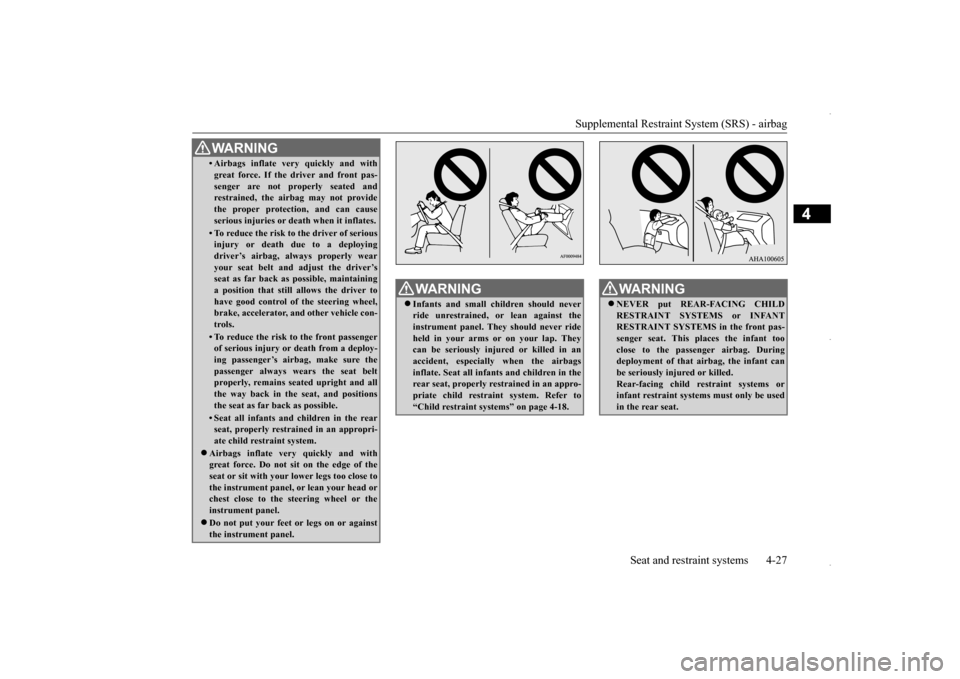
Supplemental Restraint System (SRS) - airbag
Seat and restraint systems 4-27
4
• Airbags inflate very quickly and with great force. If the driver and front pas- senger are not properly seated and restrained, the airbag may not provide the proper protection, and can causeserious injuries or de
ath when it inflates.
• To reduce the risk to the driver of serious injury or death due to a deploying driver’s airbag, always properly wear your seat belt and adjust the driver’sseat as far back as possible, maintaining a position that still allows the driver to have good control of the steering wheel,brake, accelerator, and other vehicle con- trols.• To reduce the risk to the front passengerof serious injury or death from a deploy- ing passenger’s airbag, make sure thepassenger always wears the seat belt properly, remains seated upright and all the way back in the seat, and positionsthe seat as far back as possible.• Seat all infants and children in the rearseat, properly restrained in an appropri- ate child restraint system.
Airbags inflate very quickly and with great force. Do not sit on the edge of the seat or sit with your lower legs too close to the instrument panel, or lean your head or chest close to the steering wheel or theinstrument panel. Do not put your feet or legs on or against the instrument panel.WA R N I N G
WA R N I N G Infants and small children should never ride unrestrained, or lean against the instrument panel. They should never ride held in your arms or on your lap. Theycan be seriously injured or killed in an accident, especially when the airbags inflate. Seat all infant
s and children in the
rear seat, properly restrained in an appro- priate child restraint system. Refer to “Child restraint systems” on page 4-18.
WA R N I N G NEVER put REAR-FACING CHILD RESTRAINT SYSTEMS or INFANT RESTRAINT SYSTEMS in the front pas-senger seat. This places the infant too close to the passenger airbag. During deployment of that airbag, the infant canbe seriously injured or killed. Rear-facing child restraint systems or infant restraint systems must only be usedin the rear seat.
BK0229600US.bo
ok 27 ページ 2015年10月1日 木曜日 午後2時29分
Page 49 of 398
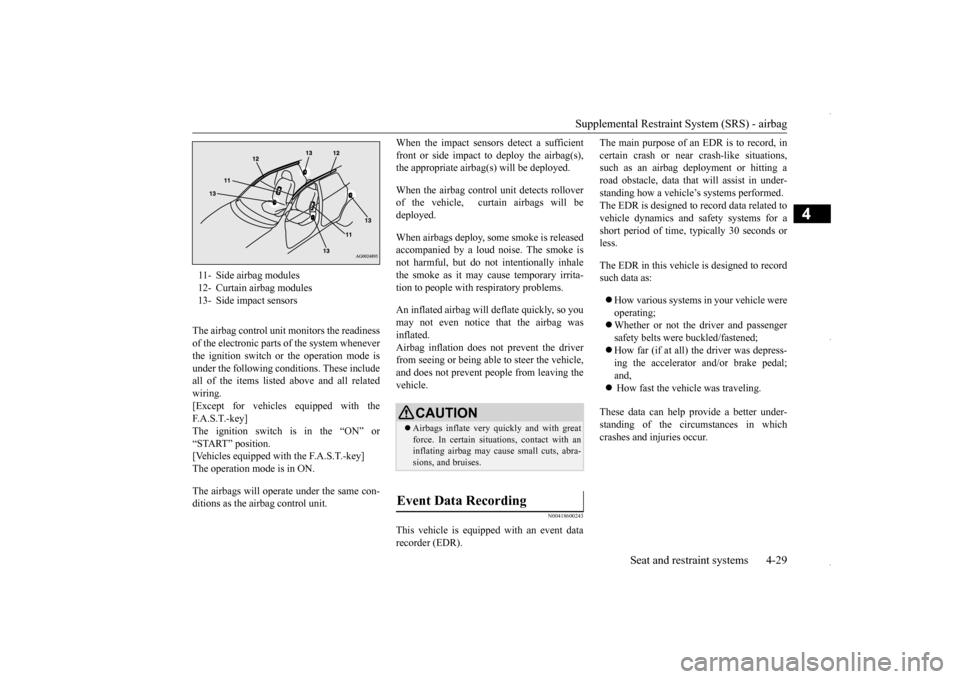
Supplemental Restraint System (SRS) - airbag
Seat and restraint systems 4-29
4
The airbag control unit monitors the readiness of the electronic parts of the system whenever the ignition switch or the operation mode is under the following conditions. These includeall of the items listed above and all relatedwiring. [Except for vehicles equipped with the F. A . S . T. - k e y ] The ignition switch is in the “ON” or “START” position. [Vehicles equipped with the F.A.S.T.-key]The operation mode is in ON. The airbags will operate under the same con- ditions as the airbag control unit.
When the impact sensors detect a sufficient front or side impact to deploy the airbag(s), the appropriate airbag(s) will be deployed. When the airbag control unit detects rollover of the vehicle, curtain airbags will bedeployed. When airbags deploy, some smoke is released accompanied by a loud noise. The smoke is not harmful, but do not intentionally inhalethe smoke as it may cause temporary irrita-tion to people with respiratory problems. An inflated airbag will deflate quickly, so you may not even notice that the airbag was inflated.Airbag inflation does not prevent the driver from seeing or being able to steer the vehicle, and does not prevent people from leaving thevehicle.
N00418600243
This vehicle is equipped with an event datarecorder (EDR).
The main purpose of an EDR is to record, in certain crash or near crash-like situations, such as an airbag deployment or hitting a road obstacle, data that will assist in under-standing how a vehicle’s systems performed. The EDR is designed to record data related to vehicle dynamics and safety systems for ashort period of time, typically 30 seconds or less. The EDR in this vehicle is designed to record such data as: How various systems in your vehicle were operating; Whether or not the driver and passenger safety belts were buckled/fastened; How far (if at all) the driver was depress- ing the accelerator and/or brake pedal; and, How fast the vehicle was traveling.
These data can help provide a better under- standing of the circumstances in which crashes and injuries occur.
11- Side airbag modules 12- Curtain airbag modules13- Side impact sensors
CAUTION Airbags inflate very quickly and with great force. In certain situations, contact with an inflating airbag may cause small cuts, abra- sions, and bruises.
Event Data Recording
BK0229600US.bo
ok 29 ページ 2015年10月1日 木曜日 午後2時29分
Page 76 of 398
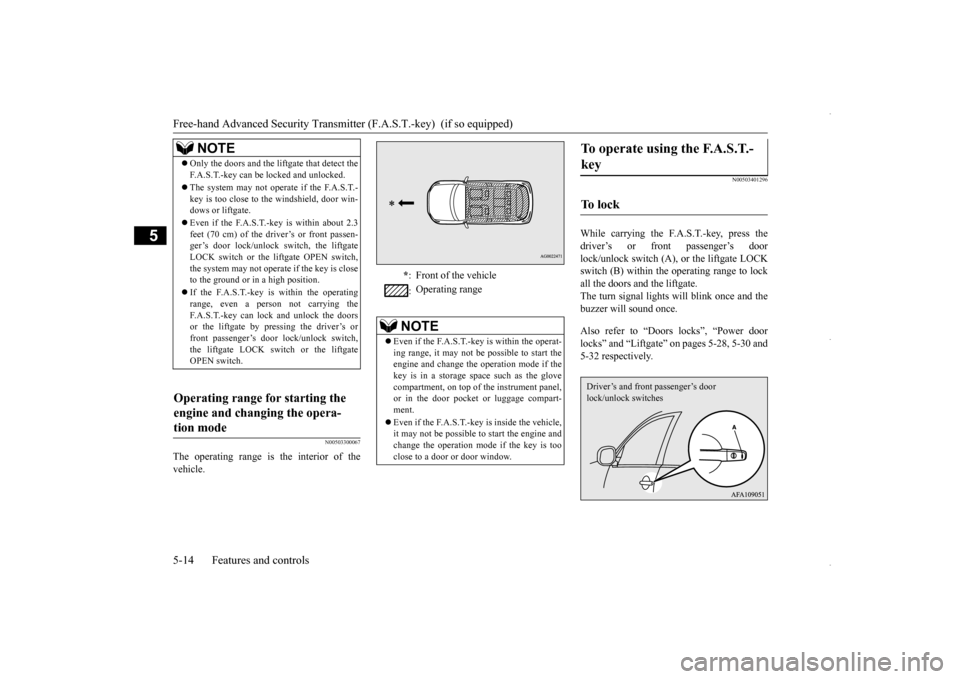
Free-hand Advanced Security Transmitte
r (F.A.S.T.-key) (if so equipped)
5-14 Features and controls
5
N00503300067
The operating range is the interior of the vehicle.
N00503401296
While carrying the F.A.S.T.-key, press thedriver’s or front passenger’s door lock/unlock switch (A), or the liftgate LOCK switch (B) within the operating range to lockall the doors and the liftgate.The turn signal lights will blink once and the buzzer will sound once. Also refer to “Doors locks”, “Power door locks” and “Liftgate” on pages 5-28, 5-30 and5-32 respectively.
NOTE
Only the doors and the liftgate that detect the F.A.S.T.-key can be locked and unlocked. The system may not operate if the F.A.S.T.- key is too close to the windshield, door win-dows or liftgate. Even if the F.A.S.T.-key is within about 2.3 feet (70 cm) of the driver’s or front passen- ger’s door lock/unlock switch, the liftgate LOCK switch or the liftgate OPEN switch,the system may not operate if the key is close to the ground or in a high position. If the F.A.S.T.-key is within the operating range, even a person not carrying the F.A.S.T.-key can lock and unlock the doorsor the liftgate by pressing the driver’s or front passenger’s door lock/unlock switch, the liftgate LOCK switch or the liftgateOPEN switch.
Operating range for starting the engine and changing the opera- tion mode
* : Front of the vehicle : Operating range
NOTE
Even if the F.A.S.T.-key is within the operat- ing range, it may not be possible to start the engine and change the operation mode if thekey is in a storage space such as the glove compartment, on top of
the instrument panel,
or in the door pocket or luggage compart-ment. Even if the F.A.S.T.-key is inside the vehicle, it may not be possible to start the engine and change the operation mode if the key is too close to a door or door window.
To operate using the F.A.S.T.- key
To l o c k
Driver’s and front passenger’s door lock/unlock switches
BK0229600US.bo
ok 14 ページ 2015年10月1日 木曜日 午後2時29分
Page 77 of 398

Free-hand Advanced Security Transmitt
er (F.A.S.T.-key) (if so equipped)
Features and controls 5-15
5
While carrying the F.A.S.T.-key within the operating range, you can unlock the doorsand the liftgate by using the F.A.S.T.-key.The dome light will turn on for 30 seconds. The turn signal lights will blink twice and the buzzer will sound twice. Also refer to “Door locks”, “Power door locks” and “Liftgate” on pages 5-28, 5-30 and 5-32 respectively. Press the driver’s door lock/unlock switch (A) to unlock only the driver’s door.Within about 2 seconds, press the driver’s door lock/unlock switch one more time to unlock all the doors and the liftgate.
Press the front passenger’s door lock/unlock switch (B) or the liftgate OPEN switch (C) tounlock all the doors and the liftgate.
NOTE
On vehicles equipped with the mirror retrac- tor switch, the outside rearview mirrors will automatically retract when all doors and lift-gate are locked using the driver’s or front passenger’s door lock/unlock switch (A) or the liftgate LOCK switch (B). In cases such as the following, the F.A.S.T.- key does not operate. • There is a F.A.S.T.-key in the passenger compartment • A door or the liftga
te is open or ajar
• The operation mode is not in OFF. The liftgate OPEN switch (C) can be used to confirm that the vehicle is locked properly. Press the liftgate OPEN switch within about 3 seconds of locking. If the liftgate OPEN switch is pressed 3 sec- onds or more after the vehicle is locked, thedoors and the liftgate are unlocked.Liftgate switches
The time within which locking confirmation is possible can be adjusted. See an autho- rized Mitsubishi Motors dealer for details.
To u n l o c k
NOTE
NOTE
On vehicles equipped with the mirror retrac- tor switch, the outside rearview mirrors will automatically extend when the driver’s dooris unlocked using the driver’s lock/unlock switch (A), front passenger’s door lock/unlock switch (B) or the liftgate OPENswitch (C). Settings can be changed so that all doors and the liftgate are unlocked automatically by pressing the driver’s door lock/unlock switch once.Refer to “Setting the door and liftgate unlock function” on page 5-26.Driver’s door lock/unlock switch
BK0229600US.bo
ok 15 ページ 2015年10月1日 木曜日 午後2時29分
Page 90 of 398
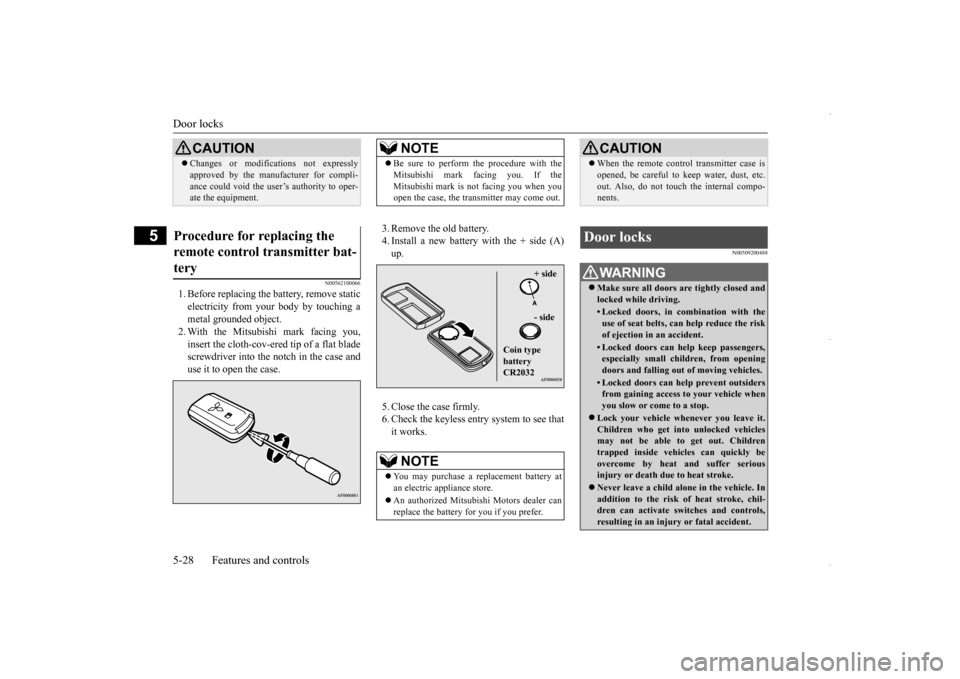
Door locks 5-28 Features and controls
5
N00562100066
1. Before replacing the battery, remove static electricity from your body by touching a metal grounded object. 2. With the Mitsubishi mark facing you,insert the cloth-cov-ered tip of a flat blade screwdriver into the notch in the case and use it to open the case.
3. Remove the old battery. 4. Install a new battery with the + side (A) up. 5. Close the case firmly. 6. Check the keyless entry system to see that it works.
N00509200488
CAUTION Changes or modifications not expressly approved by the manufacturer for compli- ance could void the user’s authority to oper- ate the equipment.
Procedure for replacing the remote control transmitter bat-tery
NOTE
Be sure to perform the procedure with the Mitsubishi mark facing you. If the Mitsubishi mark is not facing you when you open the case, the transmitter may come out.NOTE
You may purchase a replacement battery at an electric appliance store. An authorized Mitsubishi Motors dealer can replace the battery for you if you prefer.
+ side - side
Coin type battery CR2032
CAUTION When the remote control transmitter case is opened, be careful to keep water, dust, etc. out. Also, do not touch the internal compo- nents.
Door locks
WA R N I N G Make sure all doors are tightly closed and locked while driving.• Locked doors, in combination with theuse of seat belts, can help reduce the risk of ejection in an accident.• Locked doors can help keep passengers,especially small children, from opening doors and falling out of moving vehicles.• Locked doors can help prevent outsidersfrom gaining access to your vehicle whenyou slow or come to a stop.
Lock your vehicle whenever you leave it. Children who get into unlocked vehicles may not be able to get out. Children trapped inside vehicles can quickly be overcome by heat and suffer serious injury or death due to heat stroke. Never leave a child alone in the vehicle. In addition to the risk of heat stroke, chil-dren can activate switches and controls, resulting in an injury or fatal accident.
BK0229600US.bo
ok 28 ページ 2015年10月1日 木曜日 午後2時29分
Page 94 of 398
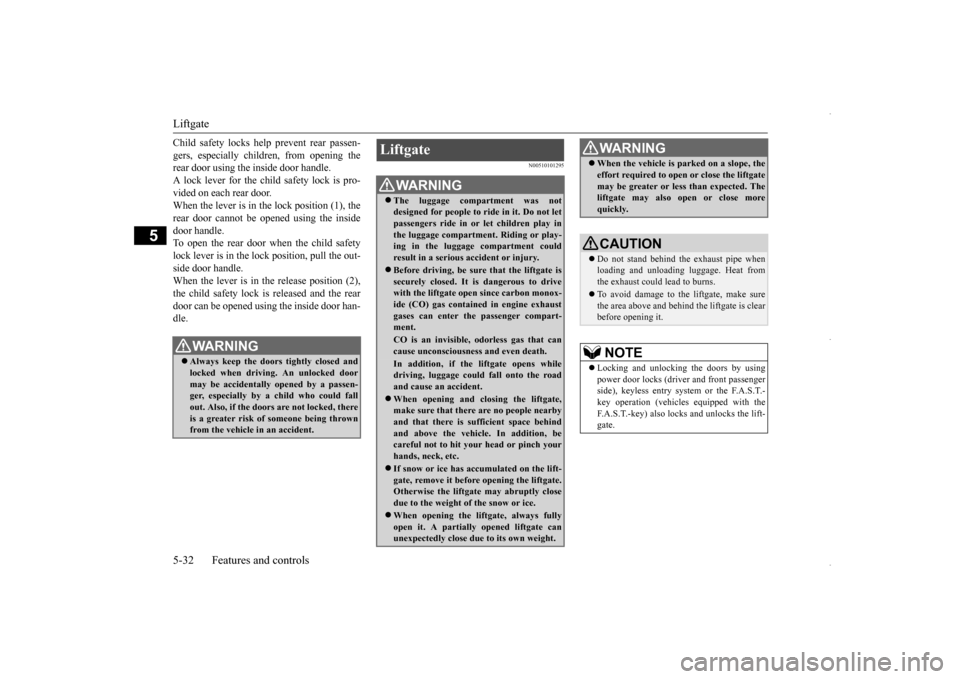
Liftgate 5-32 Features and controls
5
Child safety locks help prevent rear passen- gers, especially children, from opening the rear door using the inside door handle. A lock lever for the child safety lock is pro-vided on each rear door. When the lever is in the lock position (1), the rear door cannot be opened using the insidedoor handle. To open the rear door when the child safety lock lever is in the lock position, pull the out-side door handle.When the lever is in the release position (2), the child safety lock is released and the rear door can be opened using the inside door han-dle.
N00510101295
WA R N I N G Always keep the doors tightly closed and locked when driving. An unlocked door may be accidentally opened by a passen- ger, especially by a child who could fallout. Also, if the doors are not locked, there is a greater risk of someone being thrown from the vehicle in an accident.
Liftgate
WA R N I N G The luggage compartment was not designed for people to ride in it. Do not let passengers ride in or let children play in the luggage compartment. Riding or play-ing in the luggage compartment could result in a serious accident or injury. Before driving, be sure that the liftgate is securely closed. It is dangerous to drive with the liftgate open
since carbon monox-
ide (CO) gas contained in engine exhaust gases can enter the passenger compart- ment.CO is an invisible, odorless gas that cancause unconsciousness and even death.In addition, if the liftgate opens whiledriving, luggage could fall onto the roadand cause an accident. When opening and closing the liftgate, make sure that there are no people nearby and that there is sufficient space behind and above the vehicle. In addition, becareful not to hit your head or pinch your hands, neck, etc. If snow or ice has accumulated on the lift- gate, remove it before opening the liftgate. Otherwise the liftgate may abruptly close due to the weight of the snow or ice. When opening the liftgate, always fully open it. A partially opened liftgate can unexpectedly close due to its own weight.
When the vehicle is parked on a slope, the effort required to open or close the liftgate may be greater or less than expected. The liftgate may also open or close more quickly.CAUTION Do not stand behind the exhaust pipe when loading and unloading luggage. Heat from the exhaust could lead to burns. To avoid damage to the liftgate, make sure the area above and behind the liftgate is clear before opening it.NOTE
Locking and unlocking the doors by using power door locks (driver and front passenger side), keyless entry system or the F.A.S.T.-key operation (vehicles equipped with the F.A.S.T.-key) also locks and unlocks the lift- gate.WA R N I N G
BK0229600US.bo
ok 32 ページ 2015年10月1日 木曜日 午後2時29分